Breeds of Alpacas - HIJ
A |
B |
C |
DEFG |
HIJ |
KL |
M |
NOPQ |
R |
S |
TUVWXYZ
|
 Hamburg Hamburg
|
|
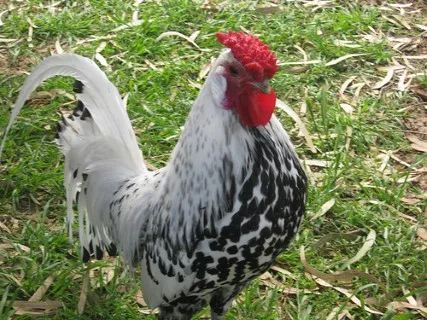 Hamburg chickens lay four small, white, flavor-packed eggs a
week. What they lack in egg size, they make up in longevity. Hamburgs
consistently lay for many years. In fact, the Dutch called them “everlayers.”
Hamburg hens mature early and start laying at four months of age. The chicks
have a delicate constitution, but once established, the breed proves quite
robust. Hamburgs like to forage and will fly the coop to do so. Fortunately,
they tolerate cold and can endure a night away from the coop. They are an
active breed and they often refuse to sit long enough to hatch their brood.
Hamburg chickens lay four small, white, flavor-packed eggs a
week. What they lack in egg size, they make up in longevity. Hamburgs
consistently lay for many years. In fact, the Dutch called them “everlayers.”
Hamburg hens mature early and start laying at four months of age. The chicks
have a delicate constitution, but once established, the breed proves quite
robust. Hamburgs like to forage and will fly the coop to do so. Fortunately,
they tolerate cold and can endure a night away from the coop. They are an
active breed and they often refuse to sit long enough to hatch their brood.
Hamburgs have a wild disposition. They like to fly, forage,
and roost in trees. Owners have awoken to find their whole flock in the trees.
Hu
...
|
 |
|
 Holland Holland
|
|
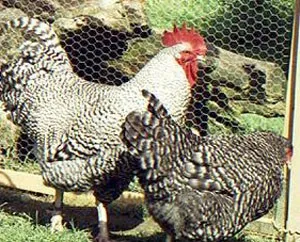 Holland chickens
are dual purpose birds developed at the Rutgers Breeding Farms in New
Jersey,US. They were created with birds imported from Holland crossed with
White Leghorns, Rhode Island Reds, New Hampshires, and Lamonas, which created
the White Hollands. Another cross included White Leghorns, Barred Plymouth
Rocks, Australorps and Brown Leghorns that produced the barred variety of
Hollands. Both were accepted by the American Poultry Association in 1949.
Holland chickens
are dual purpose birds developed at the Rutgers Breeding Farms in New
Jersey,US. They were created with birds imported from Holland crossed with
White Leghorns, Rhode Island Reds, New Hampshires, and Lamonas, which created
the White Hollands. Another cross included White Leghorns, Barred Plymouth
Rocks, Australorps and Brown Leghorns that produced the barred variety of
Hollands. Both were accepted by the American Poultry Association in 1949.
White Hollands
have pure white plumage without any other colors. Barred Hollands have black
and white barred feathers covering the entire chicken. Holland hens have a
darker plumage than the roosters. Roosters weigh eight pounds, and the hens
weight six. Holl
...
|
 |
|
 Houdan Houdan
|
|
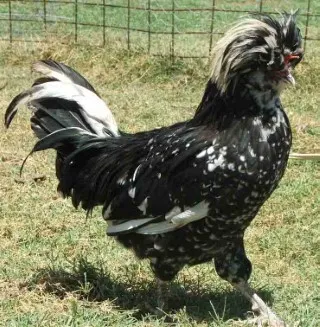 Houdans are
dual-purpose chicken. In France they have a reputation as a high class table
fowl. Houdans produce a juicy, white meat with fine bones. They are also fair
egg producers: they lay two eggs a week for eight to ten years. Chicks mature
quickly without issues. They handle confinement; although, they prefer
foraging. Houdans can live on any soil type and secure most of their food by
their own efforts. The ornamental Houdan does better in warm, dry climates.
Their heavy head feathering freezes when cold and wet. Houdans produce less
offal than other breeds resulting in fewer parasites in the soils under them.
Houdans are
dual-purpose chicken. In France they have a reputation as a high class table
fowl. Houdans produce a juicy, white meat with fine bones. They are also fair
egg producers: they lay two eggs a week for eight to ten years. Chicks mature
quickly without issues. They handle confinement; although, they prefer
foraging. Houdans can live on any soil type and secure most of their food by
their own efforts. The ornamental Houdan does better in warm, dry climates.
Their heavy head feathering freezes when cold and wet. Houdans produce less
offal than other breeds resulting in fewer parasites in the soils under them.
Houdans enjoy
human interaction. If handled early, the hens make great pets for children.
Houdan roos
...
|
 |
|
 Iowa Blue Iowa Blue
|
|
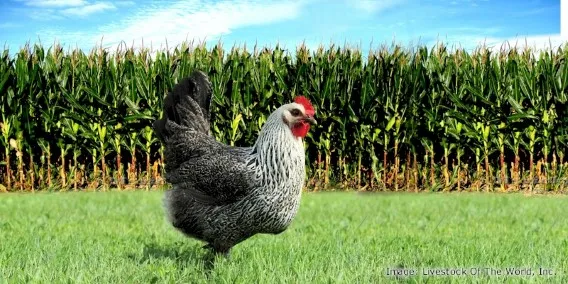 The Iowa Blue
was developed in the early 1900''s near Decorah, Iowa. A folk legend tells the
story of a white Plymouth Rock hen emerging from under a building with a clutch
of chicks colored solid chestnut to striped. Old-timers tell the tale that the
chicks were sired by a pheasant. The breed was carried by several Iowa
hatcheries through the 1960s, but was nearly lost when the hatcheries went out
of business. The breed was rescued from near extinction and has been bred and
preserved through the efforts of a few breeders since the late 1980s. The Iowa
Blue grew in popularity in 2011 with a group of dedicated breeders working to
preserve and return the breed to its original type and purpose.
The Iowa Blue
was developed in the early 1900''s near Decorah, Iowa. A folk legend tells the
story of a white Plymouth Rock hen emerging from under a building with a clutch
of chicks colored solid chestnut to striped. Old-timers tell the tale that the
chicks were sired by a pheasant. The breed was carried by several Iowa
hatcheries through the 1960s, but was nearly lost when the hatcheries went out
of business. The breed was rescued from near extinction and has been bred and
preserved through the efforts of a few breeders since the late 1980s. The Iowa
Blue grew in popularity in 2011 with a group of dedicated breeders working to
preserve and return the breed to its original type and purpose.
With its
plucky attitud
...
|
 |
|
 Italian Naked Neck Italian Naked Neck
|
|
 Italian Naked Neck, or Collo nudo italiana, chickens comes from Veneto (North-East of Italy). They probably originally came from Africa.
Italian Naked Neck, or Collo nudo italiana, chickens comes from Veneto (North-East of Italy). They probably originally came from Africa.
The hens are excellent layers and the eggs are large and white 160-180 eggs a year, 58-62 g each). Their meat is delicate with thin skin. Their subcutaneous and abdominal fat is nearly absent.
They are very rustic and perfect for outdoor rearing, but poorly adapted to industrial production.
In the US the they are known as Polish Frizzle and the liveries are the same of the Polish. Recently they have been re-imported to Italy from the U.S. Source: Agraria.org
|
 |
|
 Italian Polish Italian Polish
|
|
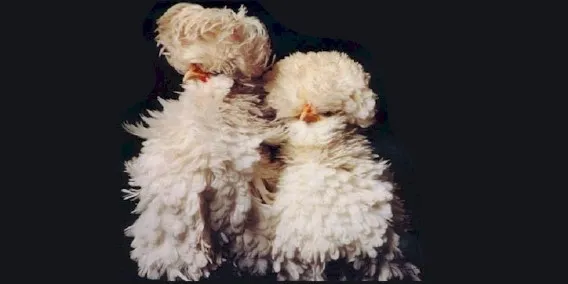 Italian Polish,
or padovana, chickens are an ancient breed with uncertain origins. According to
Darwin, it came from Poland. It probably arrived in Italy in XIV century,
brought by Giovanni Dondi dell’Orologio, nobleman from Padua, eminent doctor
and astronomer, fascinated by the beauty of those chickens.
Italian Polish,
or padovana, chickens are an ancient breed with uncertain origins. According to
Darwin, it came from Poland. It probably arrived in Italy in XIV century,
brought by Giovanni Dondi dell’Orologio, nobleman from Padua, eminent doctor
and astronomer, fascinated by the beauty of those chickens.
The origin is
anyway confused, mingling with the origin of the Polish and the Dutch, which is
tuffled but not bearded. Many quotations of XVI century talk about a
particularly famous and productive chicken in Padua county. The Padovana dal
Gran Ciuffo has been described in the work Ornithologiae by Ulisse Aldovrandi
(1600).
The decline of
Padovana begun in XIX century. At the beginning of 1900 there still we
...
|
 |
|
 Ixworth Ixworth
|
|
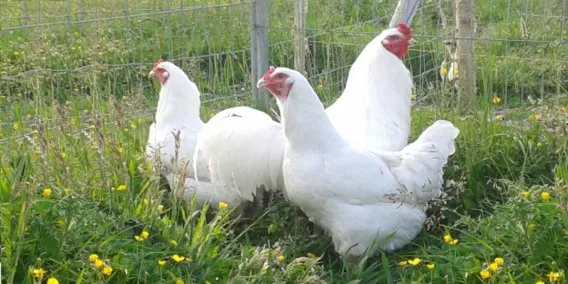 Ixworth
chickens were developed by Reginald Appleyard in 1932 in the East Anglian
county of Suffolk, England, in the village of Ixworth. Mr. Appleyard (the
inventor of the Appleyard Duck) was looking to create the ideal dual-purpose
chicken. His aim was to create a fast-growing table chicken, with respectable
laying ability. Development involved white Sussex, white Minorca, white
Orpington, Jubilee, and Indian Game.
Ixworth
chickens were developed by Reginald Appleyard in 1932 in the East Anglian
county of Suffolk, England, in the village of Ixworth. Mr. Appleyard (the
inventor of the Appleyard Duck) was looking to create the ideal dual-purpose
chicken. His aim was to create a fast-growing table chicken, with respectable
laying ability. Development involved white Sussex, white Minorca, white
Orpington, Jubilee, and Indian Game.
The Ixworth
was a hit in the British poultry markets in the mid 1930’s-1940’s. In its
heyday, Ixworth chickens fetched a top price for their premium meat. However
its popularity flared quickly, and within a decade, the demand for them drastically
declined.
At about same
time that the American p
...
|
 |
|
 Japanese Bantams Japanese Bantams
|
|
 Japanese
Bantams are show birds and pets. Technically a bantam is not a miniature
version of a standard bird. A true bantam, for example, the Japanese Bantam has
but one size.
Japanese
Bantams are show birds and pets. Technically a bantam is not a miniature
version of a standard bird. A true bantam, for example, the Japanese Bantam has
but one size.
They are warm-weather
fowl, they function best in warm, clean confinement. They love to forage in the
lawn and do so without damaging the garden or yard. They help rid the soil of
insects and weed seeds. Although small, Japanese Bantams have all the character
and color of a standard size fowl. Japanese Bantams also has a voice equal to a
standard chicken. The rooster can make a very loud and shrill noise. Japanese
Bantams can live thirteen years and will give a family many years of fun filled
enjoyment.
Japanese
Bantams have
...
|
 |
|
 Java Java
|
|
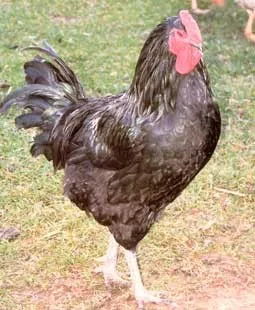 Javas are
dual-purpose chickens. They excel in meat production and Java hens lays two,
medium brown eggs a week. By commercial standards they mature slowly; however,
their maturation rates prove sufficient for the small scale farmer. Given their
large size, the backyard farmer can butcher a young cockerel and still have a
respectable-size, table bird for a family. Their black pin feathers serve as
quality control indicators over the plucking process by showing missed
feathers.
Javas are
dual-purpose chickens. They excel in meat production and Java hens lays two,
medium brown eggs a week. By commercial standards they mature slowly; however,
their maturation rates prove sufficient for the small scale farmer. Given their
large size, the backyard farmer can butcher a young cockerel and still have a
respectable-size, table bird for a family. Their black pin feathers serve as
quality control indicators over the plucking process by showing missed
feathers.
They do best
in warm weather. In colder climates they need a well-insulated coop. Javas meet
fifty percent of their nutrition needs by foraging which makes them an
economical fowl to rise.
They are a large
fowl breed plus do
...
|
 |
|
 Jersey Giant Jersey Giant
|
|
 Jersey
Giant weighs in as the largest purebred chicken in the world, although they are
a bit smaller that the image shown. A Jersey Giant capon can reach twenty
pounds. Unfortunately, it takes six months for the Jersey Giant to grow its
giant skeleton and another three months before it has sufficient bulk for
butchering. Their slow maturation rate makes them unviable for commercial meat
production. Jersey Giants lay three extra-large, brown eggs a week. They will brood
chicks; however, their massive size often leads to crushed eggs or chicks. In
spite of their size, Jersey Giants fit well into a small farm setting. They
have a hardy constitution for cold.
Jersey
Giant weighs in as the largest purebred chicken in the world, although they are
a bit smaller that the image shown. A Jersey Giant capon can reach twenty
pounds. Unfortunately, it takes six months for the Jersey Giant to grow its
giant skeleton and another three months before it has sufficient bulk for
butchering. Their slow maturation rate makes them unviable for commercial meat
production. Jersey Giants lay three extra-large, brown eggs a week. They will brood
chicks; however, their massive size often leads to crushed eggs or chicks. In
spite of their size, Jersey Giants fit well into a small farm setting. They
have a hardy constitution for cold.
Jersey
Giant chickens have a docile disposition. The rooster
...
|
 |
Top
|